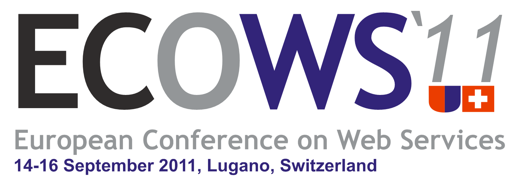You are hereKeynote Speakers
Keynote Speakers
Schahram Dustdar - Socially enhanced Services Computing

Socially enhanced Services Computing
by Univ.Prof. Dr. Schahram Dustdar, Vienna University of Technology (TU Wien), Austria
Socially enhanced Services Computing deals with a novel and exciting new field at the intersection between Social Computing, Service-oriented Computing, Crowd Computing, and Cloud Computing. In this talk I will discuss some of our models and approaches in this area. The approach discussed allows for a seamless integration of people into trusted dynamic compositions of Human-provided Services and Software-based services, thus empowering new interaction models and processes in massive collaboration scenarios in a Future Internet.
Wil van der Aalst - Business Process Configuration in the Cloud

Business Process Configuration in the Cloud: How to Support and Analyze Multi-Tenant Processes?
by Prof.dr.ir. Wil van der Aalst, Technische Universiteit Eindhoven (TU/e), The Netherlands
Lion’s share of cloud research has been focusing on performance related problems. However, cloud computing will also change the way in which business processes are managed and supported, e.g., more and more organizations will be sharing common processes. In the classical setting, where product software is used, different organizations can make ad-hoc customizations to let the system fit their needs. This is undesirable, especially when multiple organizations share a cloud infrastructure. Configurable process models enable the sharing of common processes among different organizations in a controlled manner. This paper discusses challenges and opportunities related to business process configuration. Causal nets (C-nets) are proposed as a new formalism to deal with these challenges, e.g., merging variants into a configurable model is supported by a simple union operator. C-nets also provide a good representational bias for process mining, i.e., process discovery and conformance checking based on event logs. In the context of cloud computing, we focus on the application of C-nets to cross-organizational process mining.
Stephan Murer - 13 Years of SOA at Credit Suisse

13 Years of SOA at Credit Suisse: Lessons Learned – Remaining Challenges
by Dr. Stephan Murer, IT Chief Architect at Credit Suisse AG.
Credit Suisse has been active in the field of service oriented architecture over many years. I chose the birth date of the “Credit Suisse Information Bus” 13 years ago as the starting point of a long journey towards an enterprise SOA at Credit Suisse. I have chosen a number of case studies, marking major steps in the SOA progress. Each case study starts with a strategic business need, continues with the chosen solution, and concludes with a discussion of the achievements and the remaining gaps. Putting these case studies into a historic perspective, shows a continuous evolution, where each step expands the business value, closes gaps of previous solutions, and last but not least leads to new challenges. I will illustrate each case study with examples and data.
Carlo Ghezzi - The Fading Boundary between Development Time and Run Time

The Fading Boundary between Development Time and Run Time
by Prof. Carlo Ghezzi, Politecnico di Milano, Italy
Modern software applications are often embedded in highly dynamic contexts. Changes may occur in the requirements, in the behavior of the environment in which the application is embedded, in the usage profiles that characterize interactive aspects. Changes are difficult to predict and anticipate, and are out of control of the application. Their occurrence, however, may be disruptive, and therefore the software must also change accordingly. In many cases, changes to the software cannot be handled off-line, but require the software to self-react by adapting its behavior dynamically, in order to continue to ensure the required quality of service. The big challenge in front of us is how to achieve the necessary degrees of flexibility and dynamism required in this setting without compromising dependability of the applications.










